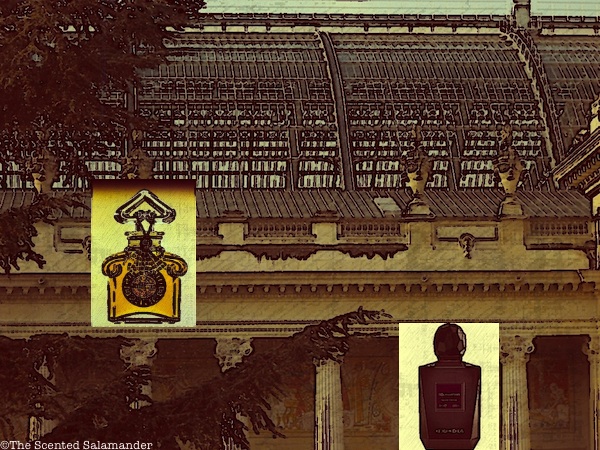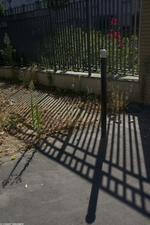A Christmas Tree, Mitsouko, Gourmandises & the Memories of Constantin Weriguine - An Overdose of Joy {Fragrant Tale & Scented Thoughts}

If there is an enchanted book about childhood memories on perfumes and scents besides a masterpiece of world literature like A la recherche du temps perdu by Marcel Proust that would be the much lesser known, more naïve book of recollections by Russian émigré perfumer Constantin Weriguine called in French Souvenirs et Parfums: Mémoires d'un parfumeur (Memories and Perfumes: Recollections of a Perfumer, 1965)...
Constantin Weriguine was a student and friend of perfumer Ernest Beaux, the creator of Chanel No.5 with whom he shared a bi-cultural Russian-French background.
Like in a movie by Mikhail Mikhalkov infused with Chekhovian accents and wistful charm, the texture of the Russian perfumer's family life in the Crimea unfolds brilliant, witty, contemplative, poetic, moving, enchanted, melancholy, all in turns.
For whomever holds memories of a happy childhood they will find in this perfumer's autobiography many echoes of this intimate feeling of irrepressible, exuberant happiness as well as a sense of childlike wonder, only more intricately woven with the threads of deep, affective olfactive memory.
In the book, there is a chapter in particular about Weriguine's family Christmas tree tradition entitled "L'arbre de Noël". Little did I suspect that it would contain a veritable mirror revelation experienced by both me and him across time. He introduces his topic by writing that,
"I believe that there is no perfume that is more complete, more suprising and more moving than that of a Christmas tree."
Follows a very rich olfactory portrait of a Christmas tree, from its wood and bark to its gourmand notes of Corinthian raisins, honeyed gingerbread, mint, marmelade, chocolate, caramels, with notes on the aldehydes wafting from the snuffed out candles. And there is more in the circumference of the fir. The young Weriguine smells everything that is on the tree and around it, offering a beautiful evocation of the tree's olfactive personality during the Holidays as it radiates around the family house.
The most intriguing part of the chapter however lies in how he reveals an unknown and deep affinity between the olfactory palette of the Christmas tree and a family of perfumes - the Chyprés. Named after the island of Cyprus, the scent of chypre is documented in historical records prior to the 20th century but it is Coty's chypre, then Crêpe de Chine by Millot which serve as modern references for what it is meant by the concept.
I have been keeping on the back-burner of my mind a warm woolen yarn to spin on this Christmas olfactory tale as I experienced four years ago a very similar, yet reverse-order olfactory sensation to the one described by the author, as I found out later when I decided it was time to read the second-hand book.
That winter of 2008, I had brushed past the Yule tree at home on a certain day, at a certain hour, with the kind of right-air current that will bring novel olfactory information to your nose : I suddenly caught whiffs of a very elegant chypre perfume, Mitsouko to be more precise. On such occasions, and if I can do it relatively politely, I normally instinctively look around me to search for the source of the scent. Since no sillages pulled me in a different direction, I went back to the tree.
Struck, smelling and really intrigued, I realized that the fir tree smelled naturally of a chypré composition, and in particular of the celebrated Mitsouko by Guerlain created in 1919. But then also, there was coming out of the branches, the scent of another perfume that I would call Christmas-y much more clearly, Gourmandises by Keiko Mecheri, a favorite for the fall-winter season. The latter needs more introduction than Mitsouko. It has always made me feel as if I were inhaling the scents of a platter of dried fruits at Christmas, laid out on a wooden table, with the shadow of a pine tree not far behind. The atmosphere is black and dark green, filled with penumber. Like in the Provençal tradition of the 13 fruits of Christmas which comprises many dried, sweetmeats, Gourmandises smells of rich, stewed fruits and sticky resins. The official list of notes includes "jam notes". But the perfume also manages to create a 3D sense of space and time.
Back to Mitsouko. It is known for being not the first, but certainly the most famous fruity chypre in the modern history of perfumery. Its peach/apricot tones mingle with a chypré base creating a pensive, reflective golden autumnal light. It epitomizes man-made sophistication rather than nature.
It was therefore a shock for me to realize that Mitsouko can be smelled on the branch, so to speak, in a state of unadorned natural nakedness, leading you to wonder whether or not Jacques Guerlain who created it might have been inspired by the natural scent of a fir tree drying down in a drawing room - or between two rooms, at Christmas, as was the case for me.
The olfactory resemblance was so uncanny, I noted down the age of the cut tree known to me: we had had it for 10 days. Before that day, it had not smelled of Mitsouko. But now, it was unmistakable. It had ripened enough to let out that famous range of 14 notes. I was sorry I could not tell what species the tree was as there are several commercial kinds. It was probably a Nordmann, the most perfumey kind and a popular varietal on the French market.
Later, it so happened that I decided to read the recollections of Constantin Weriguine during the Holidays, which are interspersed with precise olfactory descriptions of a world where everything is a pretext for sensory associations. People who spend time deciphering perfumes tend to develop a very strong and spontaneous associative memory, I have found out at least in my experience. At first, you associate a smell with a memory, but with time even a shape, a color, a sound, a word will start operating with the spontaneity of an olfactive recollection. Your brain has been flexed by cultivated synaesthesia.
I find allusive proof of this psychological evolution in the book as Weriguine writes,
"But joy reached a paroxysm when one lit up the Bengal fires of the tree, comparable to a big, radiant star. It was as if colors, sounds and perfumes had reached their perfection."
Yet, the most revelatory, mind-boggling moment for me was less the poetic vignettes depicted by the author as this passage below where Weriguine explicitly states,
"Years have passed. I've dedicated myself to perfumery. While I was studying the chypré note in perfumes, words cannot describe my stupefaction and joy to meet anew, almost 100%, the aromatic range of the Christmas tree. That range appeared especially well in Chypre by Coty, Mitsouko by Guerlain, Crêpe de Chine by Millot, and Fruit Vert by Florelle. In all of these, one can find the marvelous, clear and warm aroma of the chypre, so familiar around the perfumes, lights, and warmth of the candles at Christmas time."
The only one I didn't know in this list was Fruit Vert by Florelle (1930). After some time, I was able to find an Art-Deco bottle of it with liquid remnants of the perfume.
The association of the fruity chypre to the Christmas tree is extremely intriguing. One cannot but think that a keen nose and gardener such as Jacques Guerlain could not have missed it. I feel grateful that through attentive happenstance, I was able to verify Weriguine's intuition a little less than a century later, independently, innocently and blindly : a chypre and a fruity chypre in particular is the scent of Christmas in a warm home.
And then there is that other big monument of a perfume, Angel by Thierry Mugler - an oriental, not a chypre - which is also inspired by Christmas, more particularly an Alsatian Christmas fair in Strasburg.
Isn't it wonderful and worthwhile to consider that while we might think of such perfumes as being only gourmands or sweet or fruity, or comforting or elegant, they in fact contain the olfactory imprint of a joyous and peaceful time of the year, whenever possible, and even of childhood memories of happiness harvested during the holidays? One may forget the angelic part of Angel due to its gourmand tones and big personality, but it is there, kept somewhere inside the pale baby-blue glass of its star-shaped flacon.
Would joy be the essential ingredient needed in perfume to overcome an indifferent death? So many perfumes are discontinued. Weren't they joyful and positive enough rather than exclusive and rare enough and marketed on target ? One can think so when thinking about the moving connection which exists between the spirit of Christmas and some of the great POPULAR perfumes in the Western tradition. How long a perfume lasts in history rests, just like for super centenarians perhaps, on a greater capacity for joy of living.
Shopping Addresses :
You can buy Mitsouko at Guerlain.com; Gourmandises is available at Luckyscent.com ($115); Angel is widely available at places like Sephora, its latest iteration being steeped in leather for a limited-time only; Chypre by Coty, Crêpe de Chine by Millot and Fruit Vert by Florelle are discontinued.








